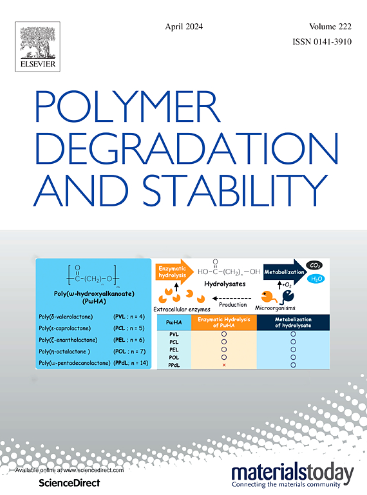Catalytic upcycling of silicone rubber by AlCl3 at low temperature
IF 6.3
2区 化学
Q1 POLYMER SCIENCE
引用次数: 0
Abstract
Chemical recycling of silicone rubber (SR) waste into valuable products has aroused ever-increasing attention; however, the development of a green, efficient degradation strategy for silicone rubber remains challenging. In this work, we report the catalytic upcycling of silicone rubber by AlCl3 to produce SiO2 under atmospheric environment. The optimized AlCl3/SR mass ratio, reaction temperature and time are 0.75, 280 ℃ and 120 min, respectively. The maximum yield of SiO2 is 96 %. The as-prepared SiO2 displays irregular spherical agglomerates with a particle size of 20–30 nm and bears rich micropores/mesopores/macropores. The result of variable-temperature Fourier-transform infrared spectroscopy proves that AlCl3 promotes the fracture of Si-O in SR during heating. According to density functional theory, the addition of AlCl3 leads to a decrease in the bond dissociation energy of Si-O and Si-C. The strategy achieves the green, efficient catalytic degradation of silicone rubber waste.
求助全文
约1分钟内获得全文
求助全文
来源期刊

Polymer Degradation and Stability
化学-高分子科学
CiteScore
10.10
自引率
10.20%
发文量
325
审稿时长
23 days
期刊介绍:
Polymer Degradation and Stability deals with the degradation reactions and their control which are a major preoccupation of practitioners of the many and diverse aspects of modern polymer technology.
Deteriorative reactions occur during processing, when polymers are subjected to heat, oxygen and mechanical stress, and during the useful life of the materials when oxygen and sunlight are the most important degradative agencies. In more specialised applications, degradation may be induced by high energy radiation, ozone, atmospheric pollutants, mechanical stress, biological action, hydrolysis and many other influences. The mechanisms of these reactions and stabilisation processes must be understood if the technology and application of polymers are to continue to advance. The reporting of investigations of this kind is therefore a major function of this journal.
However there are also new developments in polymer technology in which degradation processes find positive applications. For example, photodegradable plastics are now available, the recycling of polymeric products will become increasingly important, degradation and combustion studies are involved in the definition of the fire hazards which are associated with polymeric materials and the microelectronics industry is vitally dependent upon polymer degradation in the manufacture of its circuitry. Polymer properties may also be improved by processes like curing and grafting, the chemistry of which can be closely related to that which causes physical deterioration in other circumstances.
 求助内容:
求助内容: 应助结果提醒方式:
应助结果提醒方式:


